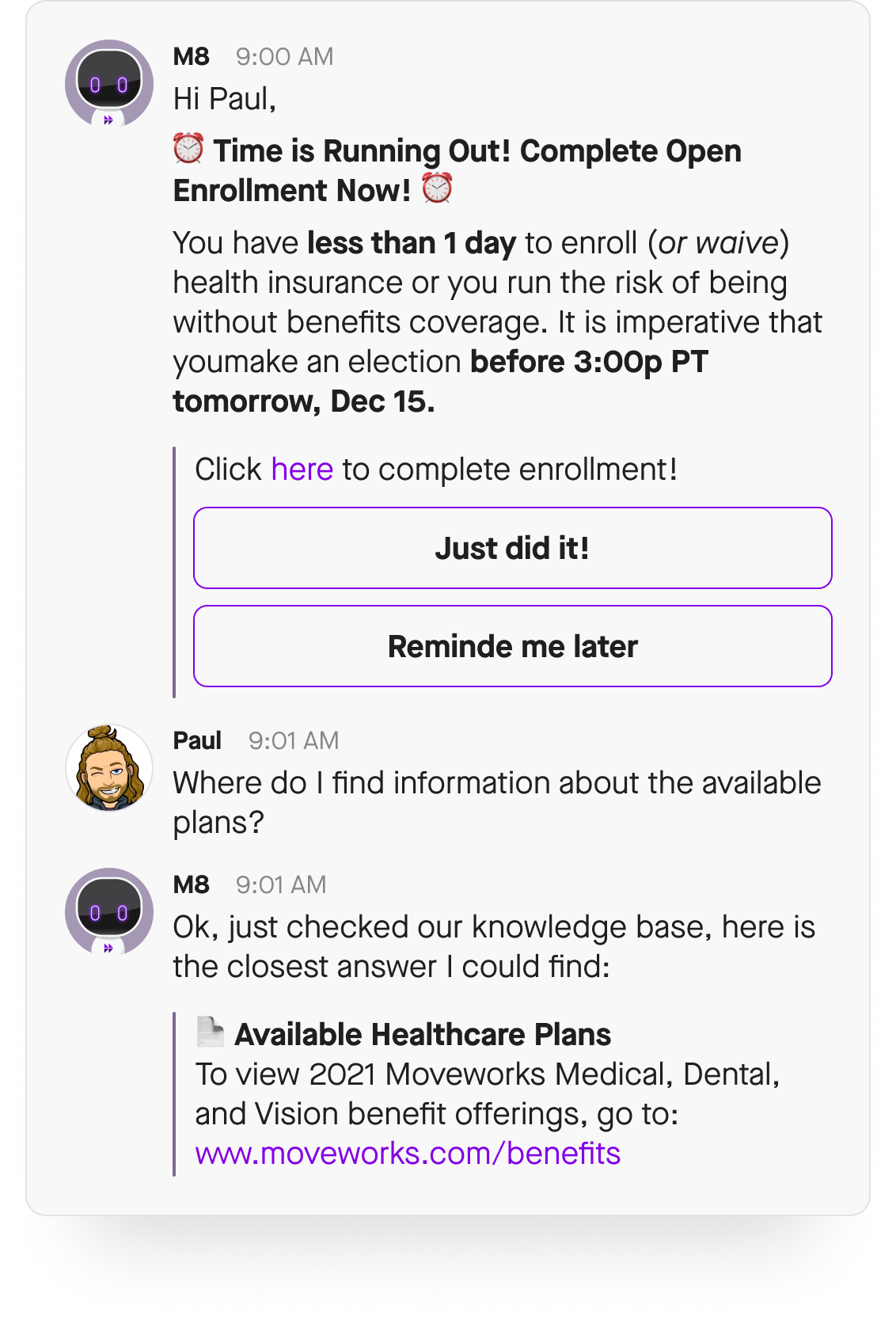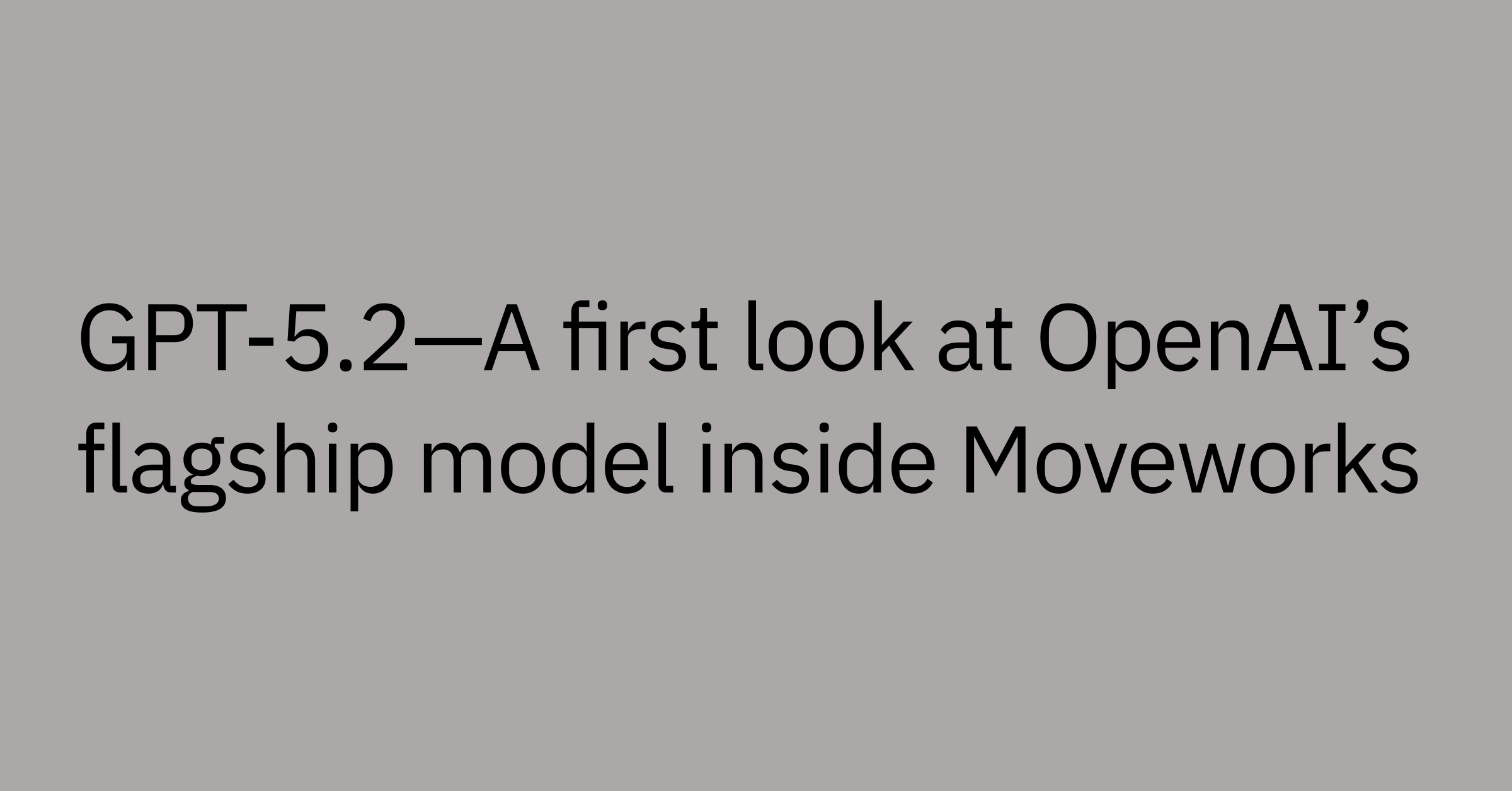Table of contents
When you need every employee to update their benefits before the deadline or to immediately change their passwords to counter a security threat, you don’t just want them to hear you — you need them to hear you. Here’s the problem: your comms are getting ignored.
Most of us are experts at one-on-one conversation. When we share a significant update with a coworker at the office, we make sure we have their attention, we explain how the news impacts them personally, and we answer their inevitable follow-up questions. Yet this common sense evaporates when we need to share that same update with thousands of coworkers simultaneously, which is the central challenge of employee comms.
Today, companies use a range of strategies to communicate with their employees en masse, from posting digital signs in the office to sending out no-reply emails. Yet these conventional strategies are noisy, impersonal, and fundamentally not interactive — the exact opposite of what makes one-on-one conversations work well. It’s no surprise that companies get only about 10% engagement with their employee comms, leaving the other 90% of the workforce vulnerable to problems that could’ve been avoided.
So the question is, how can we communicate with thousands of employees as effectively as we do one-on-one? We’ve worked with a select group of companies that are rethinking their approach to employee comms, including Robert Half, Autodesk, and Vituity. By combining enterprise collaboration tools like Slack and Microsoft Teams with artificial intelligence, they’ve achieved 50%–70% engagement with their messages, putting conventional mass communication methods to shame.
In this article, I’ll walk through the three strategies they used to fix their employee comms:
- Moving employee comms to the enterprise messaging tool
- Delivering individualized messages to only relevant recipients
- Leveraging AI to address employees’ follow-up questions and requests
One-way messages → two-way conversations
While companies increasingly recognize the importance of keeping everyone on the same page, just 37% of employees say their leaders keep them informed — and that number keeps getting lower. Ultimately, driving alignment across a scattered workforce requires a new approach altogether: engaging employees directly on collaboration tools like Microsoft Teams and Slack.
For the team at Robert Half, the sudden shift to work-from-home threw this engagement challenge into sharp relief during the early days of the pandemic. The IT team needed to transition the company to a fully digital workplace as quickly as possible. And for them, that meant getting everyone on Microsoft Teams. Just four months into their Teams promotion campaign, they saw a roughly 6X increase in adoption companywide. How did they do it? Simple — they made all roads lead to Teams.
By itself, the collaboration tool is not a magic bullet — employees can ignore chat messages too. Yet, these platforms offer two major advantages. For one, collaboration tools are reserved for colleagues and business partners, leading employees to prioritize reading messages over emails. And for another, Teams and Slack are built to mimic the interactivity of real conversations in a way that isn’t possible with in-office digital signs or portal banners. Chat platforms allow employees to ask follow-up questions, send links, and share files — all essential elements of effective comms.
Mass broadcasts → individual updates
Simply moving to an enterprise chat platform — while a step in the right direction — is not an immediate cure-all. Working with Autodesk, we saw that one of the biggest keys to increasing engagement is sending highly personalized messages. By targeting different team members, with different information, at different times, they’ve seen up to 70% response rate from their employees.
Engagement numbers are rarely so high. Conventional comms are more like putting a poster on a wall. Even if the right people are nearby, there’s no guarantee that they’re paying attention. We subconsciously tune out information that we think is irrelevant. Employees scroll past generic digital banners just like they walk by posters. And it’s the same problem when it comes to emails. Send an email at an inconvenient time, and it will fall below the fold, never to be seen again. Important messages become just more spam.
But by engaging employees at precisely the right moment with relevant information — that’s hard to ignore.
The challenge for comms teams is that manually tailoring messages to individual employees isn’t easy. It requires a high level of awareness and a complete, up-to-date understanding of everyone in the company: names, titles, roles, locations, security permissions — everything. To be successful, they need an up-to-date, 360-degree view of what’s going on to send messages that take into account time zones and have customized greetings. With this approach, employees who usually overlook mass emails learn to pay attention.
Dead ends → next steps
Sending internal comms to the right place and the right people is only half the employee engagement puzzle. The other half is building an experience where next steps are obvious and everyone can ask follow-up questions.
We’ve all opened our inbox, seen a complicated list of steps to, say, sign up for benefits, and said to ourselves, “maybe later.” The thing is that more often than not, “maybe later” means “never.” And that’s a huge problem. On top of this information overload, once an email is sent or a banner is posted, there’s very little control over whether or not people fill out the right form or submit an expense report. Just knowing how to ask a follow-up question or what to do next is rarely, if ever, clear.
But with a chatbot, every message starts a conversation instead of ending it. Employees are free to ask any question at their convenience. And since every message is sent through this single bot, comms leaders finally have visibility into who has completed the relevant task and who hasn’t. Armed with that information, they can send reminders or reply to specific questions in real-time.
Inspired by the results of our customers, we worked to apply their best practices in our own environment, with our own Moveworks bot: M8. Whenever we send a message with M8, from reminders to complete the cybersecurity training to recruiting updates to changes to the 401k policy, employees can easily ask even complex questions like, “I’m moving to Boston, do these policy updates still apply?” and get an answer in seconds.
 Figure 1: Inspired by the success of our customers, we use employee comms at Moveworks to ensure that everyone is on the same page.
Figure 1: Inspired by the success of our customers, we use employee comms at Moveworks to ensure that everyone is on the same page.
Communicate as clearly online as in person
Whether your company is in-person, hybrid, remote, or just geographically dispersed — intentional communication is essential. With fewer in-person touchpoints, organizations need to over-deliver or fall behind.
At Moveworks, we've thought intently about the challenge of employee comms. We built our platform to make communications how they should be — straightforward. Because we know and you know that real communication flows both ways, but traditional internal comms flow in only one direction.
To replicate this most successful model of communication — talking to people — and help companies communicate as clearly online as in person, we make sure that every message you send with Moveworks is accessible, customized, and actionable. So you can make change happen when you want it to happen.
Request a demo to see the Moveworks platform in action.






